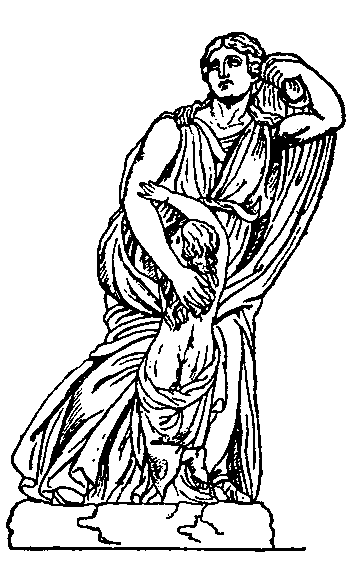|
Dictionary: Search the Dictionary Browse the Dictionary |
|
Timeline: Launch Interactive Timeline |
| Return to Front Page |
| NIOBE | |
| Daughter of Tantalus and Dione, sister of Pelops and wife of Amphion of Thebes. Like her father, she stood in close connexion with the gods, especially with Leto, the wife of Zeus, and fell into misfortune by her own arrogance. In maternal pride for her numerous progeny of six sons and six daughters, the ill-fated woman ventured to compare herself to Leto, who had only two children. To punish this presumption Apollo and Artemis slew with their arrows all Niobe's children, in their parents' palace. For nine days they lay in their blood without any to bury them, for Zeus had changed all the people into stone. On the tenth day the gods buried them. Niobe, who was changed to stone on the lonely hills of Sipylus, cannot even in this form forget her sorrow. Thus runs Homer's account [Il. xxiv 614], in which we have the earliest reference to "a colossal relief roughly carved on the rocks" of Mount Sipylus in Lydia, the face of which is washed by a stream in such a manner that it appears to be weeping [cp. Jebb on Soph., Ant. 831]. The accounts of later writers vary greatly in respect of the number of the daughters of Niobe and of the scene of her death. Sometimes the spot where the disaster occurs is Lydia, sometimes Thebes, where moreover the grave of Niobe's children was pointed out: the sons perish in the chase or on the race-course, while the daughters die in the royal palace at Thebes or at the burial of their brethren. This story describes Niobe as returning from Thebes to her home on Sipylus, and as there changed into a stone by Zeus, at her own entreaty. The fate of Niobe was often in ancient times the theme both of poetry and of art. The group of the children of Niobe discovered at Rome in 1583 and now at Florence (part of which is shown in the cut) is well-known: it is probably the Roman copy of a Greek work which stood in Pliny's time in a temple of Apollo at Rome, and with regard to which it was a moot point with the ancients whether it was from the hand of Scopas or of Praxiteles [Pliny, N. H. xxxvi 28. Cp. Stark, Niobe und die Niobiden, 1863]. | |
|
|
|
| Pictures and Media | |
| NIOBE. (Florence, Uffizi.) |

|
|
Copyright 2000-2020 Peter T. Struck. No portion of this site may be copied or reproduced, electronically or otherwise, without the expressed, written consent of the author. |